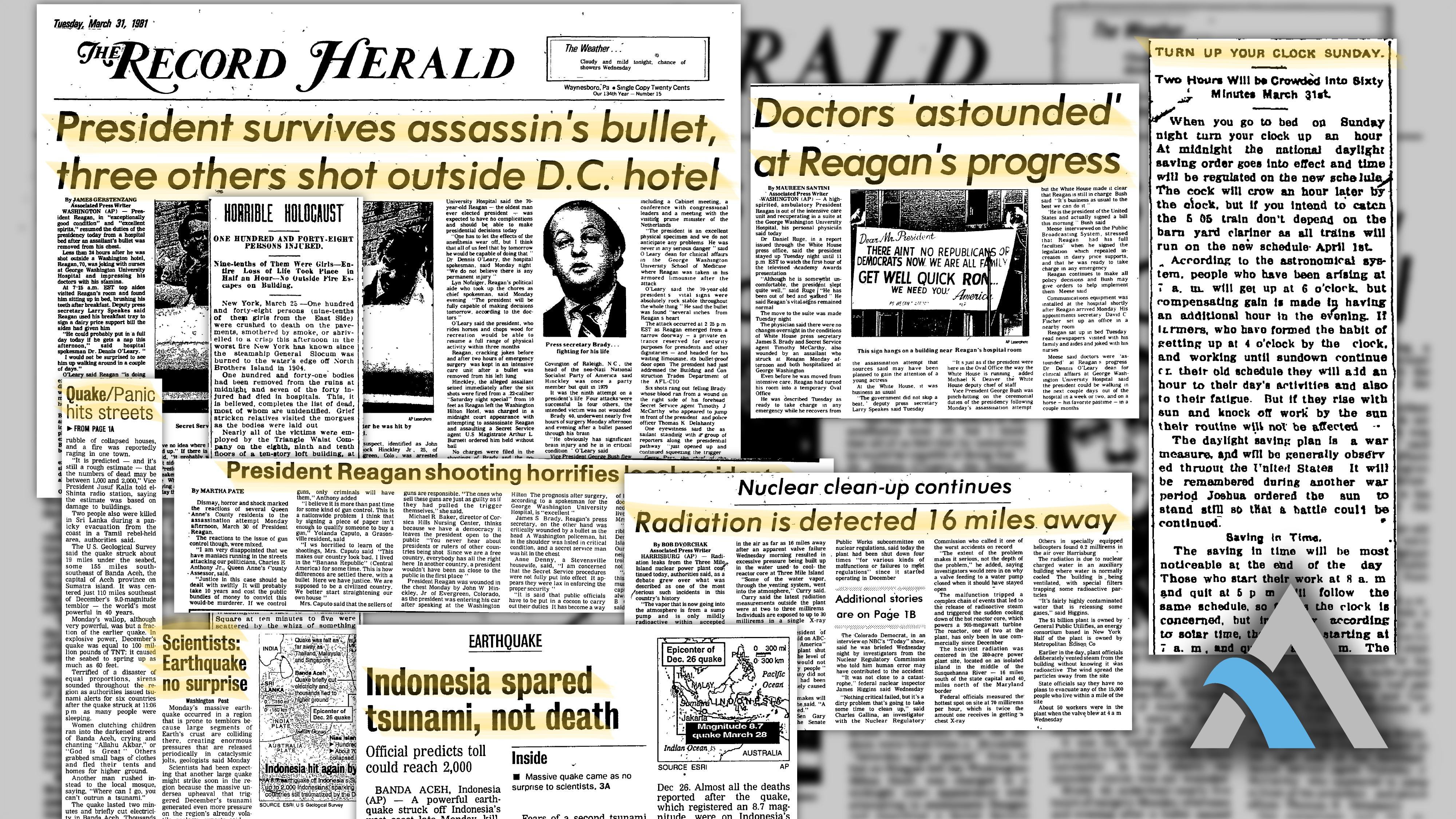This week is full of fascinating and impactful events, including a few of my favorites. With the assistance of Advantage Archives, I was able to dive deeper into these events and learn more about the first-hand reactions and thoughts following their occurrence. Between assassination attempts, fires, and nuclear explosions, this week in history provides a look back on events that shaped our world as we know it.
The Digital and Information Age (2000s – Present): Deadly Earthquake in Indonesia, 2005
On March 28th, 2005, an 8.6 magnitude earthquake occurred off the coast of Northern Sumatra, Indonesia. Scientists had been expecting an earthquake sooner or later due to trends in the earth’s environment and location that provided the perfect conditions for one. While the earthquake only lasted 2 minutes, it left behind significant damage and was followed by 8 aftershocks. In the destruction, around 1,000 people were killed. Following the quake, there was fear of a large tsunami similar to the one that hit Indonesia in the previous December. However, they were spared from additional damage, with only a small tsunami hitting Northern Sumatra,
I turned to the Cedar Rapids Community Library Community History archives to find this event. As usual, I refined my search between the dates March 28th, 2005, and April 1st, 2005 to increase my results, and searched for the word “earthquake”. From here, I browsed through the results to find the piece I thought gave me the best insight. The article I had chosen was split between the first and third pages, but it was effortless to navigate between pages, and I had no trouble finding the second part!
The Late 20th Century: Cold War and Globalization (1980s – 2000s): Attempted Assassination of President Ronald Reagan, 1981
On March 30, 1981, President Ronald Reagan was leaving the Hilton Hotel in Washington, DC. As he exited the building, Reagan and his security team were shot at by John Hinkley Jr. A bullet ricocheted off of the limousine and hit Reagan just under his left armpit. However, Reagan and his team did not realize that he had been wounded until he began to cough up blood. He was quickly rushed to the George Washington University Hospital, where he spent 12 days recovering before returning to the White House. In addition to injuring Reagan, Press Secretary James Brady, a Police Officer, and a Secret Service Agent were also wounded in the attempt.
Hinkley thought that if he were to assassinate Reagan, it would impress actress Jodie Foster. An article published in the Record-Herald describes how Hinkley wrote a letter to Foster explaining his plans and intentions. However, Foster claimed that she had never interacted with Hinkley, and only knew of the various love letters he had sent her. The letter where he discussed his plan to assassinate Reagan was never sent, but many others had been.
In the archives, I found various pieces reporting on this event. One took an interesting approach, surveying residents on their reactions. Many residents responded with a call for gun control, citing fear that their politicians are being publicly attacked. One citizen even questioned whether the Secret Service was following the right procedures for this to be happening. This same piece appeared to have been published in multiple newspapers with the same content but different titles, which I found interesting. Not only did it provide information on the attempt, but it also shared first-hand reactions in the aftermath. Another piece reported on Reagan’s Condition the following day, citing that he was in high spirits. Two days after the event, it was even said that Reagan had “turned his hospital room into a temporary Oval Office”.
To find these pieces, I went to the site directory on Advantage archives and selected a couple of archives shown near Washington DC. I started with the Queen Anne’s County Library, searching for the word “Reagan ”. For this search, I refined my dates from March 30, 1981, to April 4, 1981, in order to account for the time it would take for the news to be written about and published. Here I found an article from the Kent Island Bay times. In addition to that piece, I also searched the same criteria in the Alexander Hamilton Memorial Free Library CHA, which turned up different results. These pieces included reports on the president’s recovery and on Hinkley’s motives, which I found fascinating. The biggest piece of research advice I can give from my personal experience thus far is to search for dates around the time of the event, rather than just the day of because often the event you’re looking for won’t be written about until the following days!
Post-War Prosperity and Challenges (1945 – 1980s): Three Mile Island Nuclear Meltdown, 1979
The Three-Mile Island incident happened at a nuclear power plant near Harrisburg, Pennsylvania. At 4:00 AM on March 28, 1979, the second nuclear reactor began to have a partial core meltdown. The meltdown was caused by a malfunction with the cooling system, which allowed a buildup of heat and a partial meltdown to occur. This resulted in nuclear gasses being released into the environment. Local panic followed suit, many fearing the health effects of radiation. Though this event caused little damage to the health of the plant workers and surrounding populations, it is considered the most serious nuclear meltdown in the United States. The Three Mile Island disaster is responsible for the United States investing more time and energy into safe nuclear power procedures to prevent future meltdowns or disasters.
To find this event, I used the directory on the Advantage Archives website to find a CHA near Harrisburg Pennsylvania. Based on the directory, I turned again to the Alexander Hamilton Memorial Free Library CHA. I used the search criteria of the dates March 27th 1979 to April 2nd, 1979, and the word nuclear. I found many different articles from various stages of the disaster unfolding, including the initial report, and the response from the days following, and selected one I found the most applicable and interesting.
The World Wars Era (1914 – 1945): First Daylight Savings, 1918
Daylight Savings Time is a concept we are very familiar with today, but it took an extensive legal process for it to become the norm. The very first Daylight Savings Time went into effect on March 31st, 1918. It was a part of the Standard Time Act (STA), which passed through Congress on March 15th, 1918, and was signed into law on March 19th. The STA was a part of the American war effort, aiming to help utilize the daylight most effectively. This first daylight savings time was only in effect for 7 months. It didn’t make its return again until around World War two when permanent daylight savings was used again. Following World War two, it was up to local governments to decide whether they wanted to continue daylight savings time or not. However, it became law again in 1966 with the passing of the Uniform Time Act.
To find this piece, I decided to look into a Community History Archive that I hadn’t used before to broaden my horizons, and I selected the Rushville, Illinois CHA at random. I made a good choice because they had exactly what I was looking for! I narrowed my search to the word “daylight” from the dates March 25, 1918, to April 1st, 1918 in effort to turn up multiple results. I only got one result from this search, but luckily it was exactly what I needed. This piece from the Rushville Times was informing the population of when Daylight Savings would take place, and more interestingly, why it was happening. I found that added explanation interesting!
The Industrial Revolution to the Early 20th Century (1824 – 1914): Triangle Shirtwaist Factory Fire, 1911
The Triangle Shirtwaist Factory produced women’s blouses, also called “shirtwaists”, and employed many garment workers, most of whom were women and girls. They typically worked nine hours a day and received from $7 to $12 a week. On March 25th, 1911, workers at the Triangle Shirtwaist Factory were going about their typical workday. At 4:40 pm, a fire began on the 8th floor of the building. The cause is believed to have been an unextinguished match or a cigarette butt being thrown away in a fabric scrap bin, which contained highly flammable fabric scraps. The fire continued to grow, engulfing the factory in flames. While the factory had various exits, the fire blocked the stairway, and all other exits were locked to prevent the workers from stealing. Most of the workers were trapped inside and had to choose between burning to death, jumping out the window, or they died from smoke inhalation before they could decide. A total of 146 garment workers reportedly died that day, 123 of which were women and girls.
To find this piece, I again went to the Advantage Archives site directory and looked for CHA around the Manhattan area. Here I found the Rapides Parish Library CHA. I wasn’t sure whether searching for the name of the factory itself would produce as many results, so instead I opted to search for the word “fire” from the dates of March 25th, 1911 to April 2, 1911. This initial search provided far too many results, so I narrowed it down by changing the latest date from April 2nd to March 31st, and it was more successful. Here, I found many options to pick from covering the fire, and each had something unique!
Something I find interesting is that in the publication from the Alexandria Daily Town Talk covering the event, they say that the cause of the fire “may never be known”. Their prediction was partially correct, as there is no official confirmed cause, but in the present day, we have theories as to the most likely cause. I also think it’s interesting that they reported that the fire started on the fifth floor, while other sources reported that the fire started on the eighth floor. It is thought-provoking to look at these different reports, and they show how our knowledge changes over time as we investigate events further.


